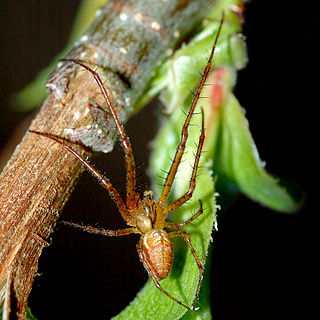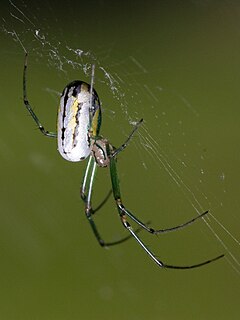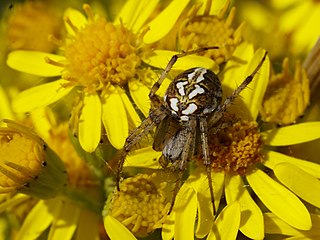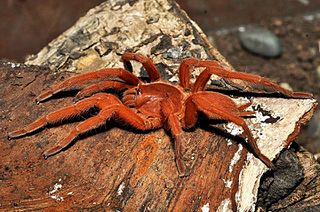
Long-jawed orb weavers or long jawed spiders (Tetragnathidae) are a family of araneomorph spiders first described by Anton Menge in 1866. They have elongated bodies, legs, and chelicerae, and build small orb webs with an open hub with few, wide-set radii and spirals with no signal line or retreat. Some species are often found in long vegetation near water.
Lepidemathis is a spider genus of the jumping spider family, Salticidae. The four described species are endemic to the Philippines.
Neobrettus is a genus of Asian jumping spiders that was first described by F. R. Wanless in 1984. The name is a combination of the prefix "neo-" and the salticid genus Brettus.

Deinopis, also known as net-casting spiders, gladiator spiders and ogre-faced spiders, is a genus of net-casting spiders that was first described by W. S. MacLeay in 1839. Its distribution is widely tropical and subtropical. They catch their prey using a specially spun "net". The name is derived from the Greek δεινός (deinos), meaning "fearful", and opis, meaning "appearance", referring to their ogre-like faces. The spelling "Dinopis" is also found, but is regarded as an "unjustified emendation".

Leucauge is a spider genus of long-jawed orb weavers, with over 160 species and fully pantropical distribution.

Neoscona, known as spotted orb-weavers and barn spiders, is a genus of orb-weaver spiders (Araneidae) first described by Eugène Simon in 1895 to separate these from other araneids in the now obsolete genus Epeira. The name Neoscona was derived from the Greek νέω, meaning "spin", and σχοῐνος, meaning "reed" They have a mostly pantropical distribution and one species, Neoscona adianta, has a palearctic distribution. As of April 2019 there are eight species that can be found in the United States and Canada:
Masteria is a genus of curtain web spiders that was first described by L. Koch in 1873. They occur in the tropics of Central to South America, Asia and Micronesia, with one species found in Australia. M. petrunkevitchi males are 4 millimetres (0.16 in) long and females are 5 millimetres (0.20 in) long. M. lewisi, M. barona, and M. downeyi are slightly smaller and have only six eyes.

Dolichognatha is a genus of tropical and subtropical long-jawed orb-weavers that was first described by Octavius Pickard-Cambridge in 1869. Originally placed with the Archaeidae, it was transferred to the Araneidae in 1967, and to the Tetragnathidae in 1981.
Prolochus is a possible genus of tropical spiders. As of September 2018, the World Spider Catalog does not accept the genus and treats it as a synonym of Dolichognatha, a genus in the family Tetragnathidae. In 2014, it was suggested that the genus be restored, and a newly discovered species was named as Prolochus junlitjri. Prolochus is said to have four main traits that distinguishes it from Dolichognatha: the total absence of posterior median eyes, a dorsal abdomen without dorsal humps, a distinct shape of abdomen and the palpal organ of the male.
Dolichognatha longiceps is a species of spider in the family Tetragnathidae, found in India, Myanmar and Thailand. In 2014, it was suggested that the species be transferred back to the genus Prolochus, where it was placed by Tamerlan Thorell in 1895, but as of May 2016, this has not been accepted by secondary sources, such as the World Spider Catalog.

Orphnaecus is a genus of tarantulas that was first described by Eugène Louis Simon in 1892. They have close to fifty lanceolate stridulatory spines on the chelicerae, known as "strikers". The male embolus has a single strong retrolateral keel. It is considered a senior synonym of Chilocosmia and Selenobrachys.

Phlogiellus is a genus of tarantulas that was first described by Reginald Innes Pocock in 1897. They are found throughout Asia and Papua New Guinea, including Indonesia, the Philippines, Papua New Guinea, China, Myanmar, Malaysia, Borneo, Thailand, the Solomon Islands and Taiwan. Phlogiellus is part Latin and part Greek, the first part being "φλóξ φλoγóϛ", meaning flame, the second part being "ellus" which is a latin diminutive suffix.
Nusatidia is a genus of Asian sac spiders first described by Christa L. Deeleman-Reinhold in 2001.

Borboropactus is a genus of crab spiders that was first described by Eugène Louis Simon in 1884.
Mollemeta is a monotypic genus of long-jawed orb-weavers endemic to Chile. It contains the single species, Mollemeta edwardsi, first described as Landana edwardsi, based on a female found in 1904. The name is a reference to "Molle", the Mapudungun word for "tree", because it builds its vertical orb webs on tree trunks. It is in a clade with Allende, Chrysometa, Dolichognatha, Meta, and Metellina due to several autapomorphies, including the unique shapes of the cymbium, conductor, and embolus.
Meotipa is a genus of comb-footed spiders that was first described by Eugène Louis Simon in 1895.

Spheropistha is a genus of Asian comb-footed spiders that was first described by T. Yaginuma in 1957.

Wendilgarda is a genus of ray spiders that was first described by Eugen von Keyserling in 1886.

Asceua is a genus of Asian ant spiders first described by Tamerlan Thorell in 1887.

The UPLB Museum of Natural History is a natural science and natural history museum within the University of the Philippines Los Baños (UPLB) campus. It serves as a center for documentation, research, and information of flora and fauna of the Philippines. The museum is one of the research and extension units of the UPLB and its role parallels that of a library for written records.











